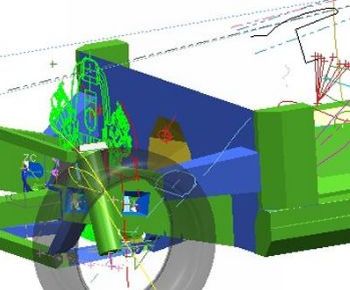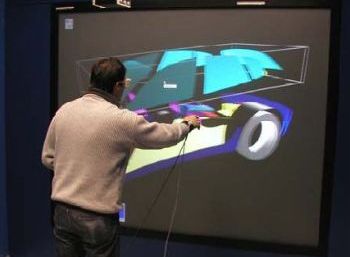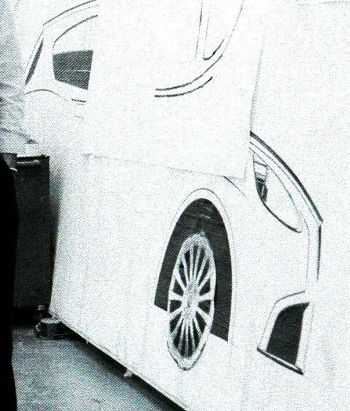|
Not long ago, a batch of photographs taken within the Alfa
Romeo Centro Stile circulated the internet, boosting
interest in the future Alfa 147 replacement, Progetto 940.
At first sight the photographs, which revealed a duo of
small clay models and a 1:1 wall tape drawing, portrayed
design proposals for a car that matched the 147 in terms of
proportion. It soon became apparent, however, that the
photographs revealed no further details of the Alfa Romeo
147 replacement, and were described by insiders as ‘looking
very different’.
The
photographs turned out to bear slightly more resemblance to
the design used on Progetto 921, the Alfa Romeo Kamal, which
has been haunted ever since its birth with a stop-start
development history. This was particularly true for the 1:1
scale wall tape drawing, which boasted a large ground
clearance to match.
A
second, more intriguing possibility for the clay models
arose, with mention of a project that had silently come and
gone, completely out of public knowledge. Consideration had
apparently gone into the development of a small Alfa Romeo,
to be positioned below the 147. Unfortunately, more
questions than answers were triggered by the photographs,
although one reasonably researchable curiosity was sparked,
namely how far Progetto 940 exactly is in the development
phase, and when we can expect to see the final product.
Earlier this year, it was stated that Alfa Romeo 147
replacement prototypes were already undergoing trials on
test tracks, with excellent handling characteristics being observed. Coupled
to the observation of a 1:1 scale body, at the Zagato
facility on Via Arese, and the project appeared to be well
underway. No photographs have so far been revealed, however,
and it has now become apparent, with fresh information, that
the car is not quite as far in its development phase as initially
perceived.
Currently,
a general design has been chosen, and is undergoing the feasibility
phase at Elasis. Using the advanced 'Unigraphics' system,
general parameters are used to test the practicality of the
design. Not only constraints, but also comfort factors are
tested, such as visibility, distance of gearlever, and
legroom. Dimensions of technical features are also fitted
into the car, such as the engine, and suspension components.
The extremes are represented by two-dimensional cross
sections, which are positioned within the virtual model.
Engineering
work is also underway, which usually starts as soon as a
general exterior shape has been derived. In the case of the
Alfa Romeo Kamal, mules based on Fiat Stilo Multiwagon
bodies were built by the Stola company, and used to test the
general platform, and driveline. Recently, the decision to
change the platform for the Kamal, for the third time, has
resulted in a temporary halt in the use of old mules. By
using mules, Alfa Romeo can develop the engineering side of
the project alongside the styling, saving valuable time.
For
testing the interior design after feasibility has been
conducted, Elasis use the “Virtalis” virtual reality
system. Fiat also use the system to incorporate all data
held on a vehicle, to embrace aerodynamics, crash test,
focus group analysis, manufacturing and marketing.
|

 |
|
Top:
Unigraphics is used to test the feasibility of a
given design. Above: An engineer at Elasis is seen using the
Virtalis virtual reality system to explore a proposed design |
|
|
 |
|
A
1:1 scale tape drawing of an Alfa Romeo, possibly a
Kamal proposal. The 147 replacement uses a
combination of sharp and soft curves, broadly similar in
effect to the new BMW 1-series, although Alfa
Romeo have been more successful |
|
|
Metodologie Sviluppo Prodotto (MSP), a department of Elasis,
has been researching VR capability since the late 1990s and
introduced Digital Mock-Up techniques into Fiat and sister
company Alfa Romeo. In mid-2002, Gennaro Monacelli, manager
of the MSP group at Elasis, decided to interlink ergonomics
with real mock-ups.
First phase of the program included the creation of a
parametric car in which all the physical relationships
between elements of the vehicle’s interior could be
electronically controlled. This was linked to a VR system,
with the driver wearing a headset. The driver could then
touch (real) proposed controls and sit in a (real) proposed
seat in a virtual car.
In May
of last year, the system was enthusiastically described by
Monacelli. “Currently, altering the distance ratios of the
various elements takes a few seconds and altering the
physical seats and steering wheels takes about an hour. This
means our top management can easily check out different
configurations early in the design process without too much
time commitment.
"Such comparisons are simply not possible
with a wholly physical model, where creating a new one might
not only take weeks but is costly to produce. Likewise, CAD
does not allow you to truly feel the car, yet with this
system, we can take CAD data and create a VR model ready for
its first ergonomic evaluation in half an hour.”
Different
drivers can also be used in the virtual realty system, to
allow for the simulation of a complete range of human
dimensions. Elasis are aiming to lower the time required for
the system to prepare itself for a new driver to a minute.
When this goal is reached, the system will then be regarded
as the high speed, flexible design environment originally
envisaged.
“We
believe our adoption and investment in advanced VR
techniques will generate better designs because we will
genuinely have considered all the options and have
thoroughly benchmarked them against our competitors. We will
initially be focusing on the driver’s comfort and the
quality of interior and exterior visibility. Beyond this
application, the protocols we have developed are feeding
into Fiat’s Virtual Reality Network, which will ultimately
encompass all the Group’s activities in a co-operative
working environment. VR will become the standard workstation
for an engineer, just as CAD systems began to be about
fifteen years ago.”
Adding
ruggedised force feedback is the next target for Elasis and
Virtalis, and is currently under development. Once this feature is
enabled, Fiat dealers will be able not only to show how a
customer’s car might look in different colours and lighting
conditions but also allow them to experience textures
created by the various finishes. Elasis is sponsoring
research at the University of Padova into how VR is accepted
by the general public.
The
use of virtual reality will ensure that the Alfa Romeo 147
replacement will be a class-leader in comfort, irrespective
of the customer type. The typical comfort problems,
associated with both short and long drivers, will be an
issue of the past. By replacing traditional techniques with
such systems, development time can be used more effectively.
Alfa Romeo are not exploiting the system to develop cars in
ground-breaking times, instead they are using the systems to
develop ground-breaking cars.
The Alfa Romeo 147 replacement,
both in three and five door format, is expected to be
revealed towards the end of 2006.
By
Patrick Granger
|
|
![]()
![]()